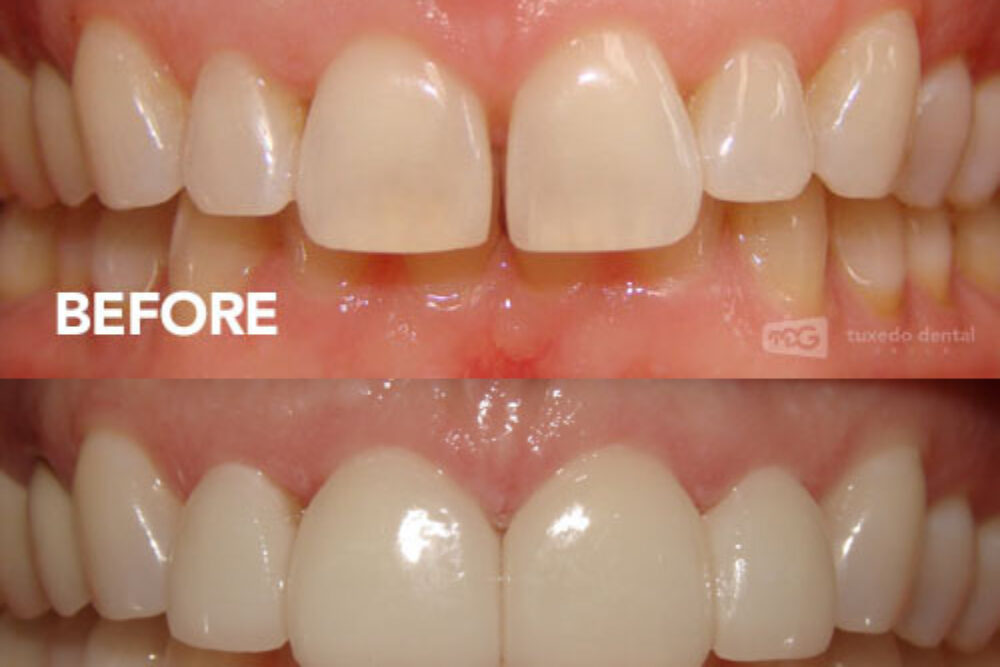
November 9, 2023
What is Dental Bonding?
A damaged tooth or teeth not only affects your appearance there are also oral health issues to consider. The good news is you have an option to repair and strengthen your teeth while improving your smile.
Your teeth deserve some credit for their strength. Even so, chips, cracks, or fractures can occur.
When that happens or if you want to simply improve their appearance, consider teeth bonding.
The treatment also known as dental bonding is a reliable procedure that can repair, strengthen, and improve the appearance of your teeth.
What is dental bonding?
Teeth bonding or dental bonding is considered a cosmetic dental treatment. The procedure uses a bonding material that consists of composite resin.

What about dental bonding vs. dental veneers?
The primary differences involve the materials used and the required tooth preparation.
Dental veneers are:
- Aesthetic ceramic shells crafted from porcelain.
- Veneers are applied to the front surfaces of your teeth and could require a small portion of your tooth’s enamel to be removed.
- Typically fabricated in a laboratory – added cost with laboratory fees.
- If damaged, can be easily removed and replaced
By comparison…
Dental bonding:
- Aesthetic tooth-coloured resins are called dental composite.
- Applied and molded directly on the tooth in putty form and hardened instantly using UV light curing.
- Typically doesn’t require a significant amount of your tooth’s enamel to be removed prior to placement.
- If damaged can be repaired or renewed chairside.
- Increased affordability over other forms of cosmetic dentistry
How common is dental bonding and when is it recommended?
If you are interested in teeth bonding, you are not alone. The treatment is common for solving a variety of dental conditions.
- If your teeth are chipped or cracked.
- If you desire to cover your discolored teeth.
- If you have gaps or spaces between your teeth.
- If you want to give your teeth a longer-looking appearance.
- If you desire to change the shape of your teeth.
Keep in mind that dental bonding is recommended for the small, cosmetic changes you want to make for your smile and the health of your teeth.
What happens during the dental bonding procedure?
The first step involves a consultation with your dentist.
- Discuss your teeth’s condition and your goals related to the appearance of your teeth.
- A comprehensive exam and x-rays will help determine the health of your teeth and gums and whether the bonding procedure will accomplish your goals.
- The presence of tooth decay or gum disease could require preliminary treatment prior to the teeth bonding procedure.
Your dental bonding procedure will follow a specific process to ensure the desired results.
- Selecting a shade that will match the natural color of your teeth.
- Preparing your tooth for the application of the bonding material and helping ensure it adheres to your tooth surface.
- Applying the composite material and molding it to the shape you desire for your tooth.
- Curing the bonding material with a curing light to enable it to harden and bond to your tooth.
- Polishing your tooth and making necessary adjustments to achieve a natural-looking appearance.
You can expect the teeth bonding procedure to last approximately 30 minutes to one hour per tooth that is being treated. It is also common for the treatment to not require anesthesia unless the bonding material is being used to treat a decayed tooth.
Book Your FREE Consultation Today!
To book an appointment for a cleaning, a specific concern or even a friendly consultation fill in the following and we will contact you promptly.
What are the risks or disadvantages of dental bonding?
Your teeth bonding procedure can provide some degree of stain resistance. Although compared to other tooth restorations such as those using porcelain, dental bonding doesn’t resist stains as effectively.
Other disadvantages you could experience:
- Although very aesthetic in nature, dental bonding may not offer the same level of aesthetics as ceramic veneers do.
- The bonding material can chip and require renewal after a period of time.
Overall, teeth bonding is a good solution for the small changes you desire for your smile. If you prefer more extensive cosmetic improvement, consult with your dentist in Winnipeg about other options.
How to take care of your teeth following a bonding procedure
You can trust your dental bonding treatment results to last with proper care.
- Follow good and effective preventive dental care routines. Brushing, flossing, rinsing with mouthwashes, and routine dental check-ups and teeth cleanings with your dentist.
Trust the strength of your teeth. And on those occasions when their durability or appearance is affected you can also trust teeth bonding as a restorative solution.
Contact your dentist in Winnipeg at Tuxedo Dental Group about your damaged, chipped, or fractured teeth.
Schedule your next dental check-up and request information about dental bonding as a solution to restore your teeth to a healthy, natural-looking, and attractive appearance.